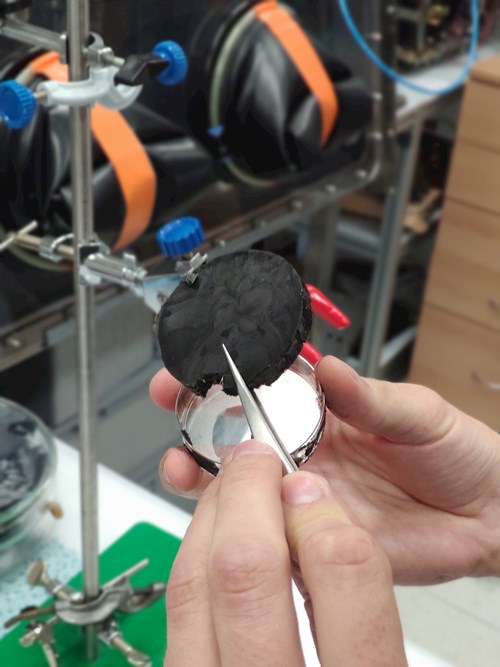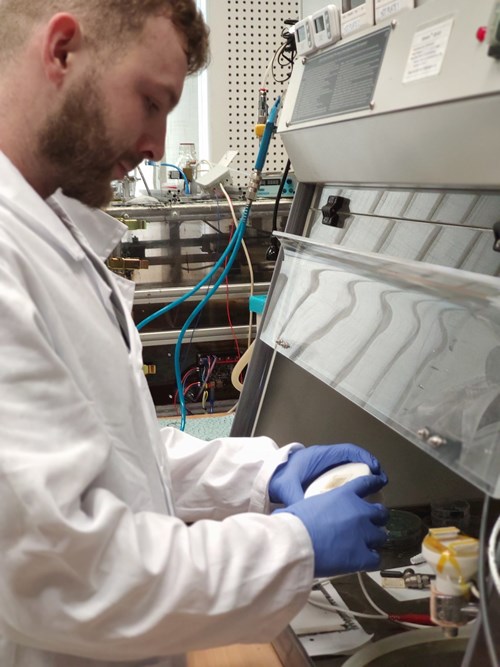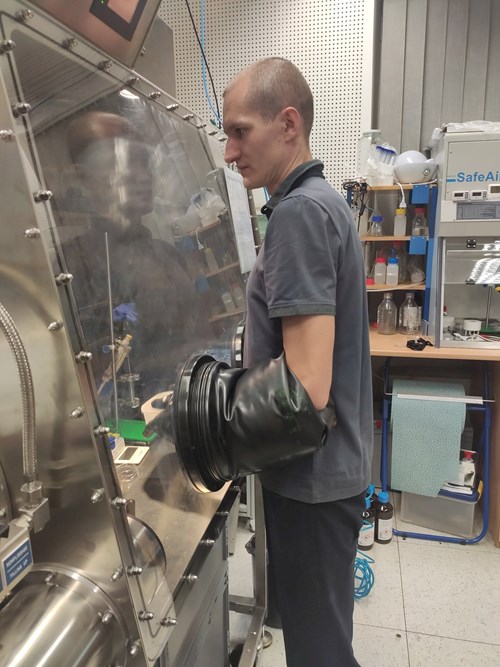Graphene oxide (GO) and reduced graphene oxide (rGO) are future materials similar to carbon nanofibers. They have a wide range of applications. rGO is attractive material for variety of electronic and optoelectronic applications (highly conductive electrical coatings, battery electrodes, solar cells, electromagnetic field shielding). rGO-based membranes are interesting for effective cleaning of water. Biosensors, gas sensors, rGO-containing polymer composites and barrier films for hydrogen storage tanks might become other applications of this material. It has a high potential for mass and cost-effective production.
Typical fabrication methods are long-term and high-energetic processes occurring at high temperatures (hundreds of °C) and the presence of various gases. The current utilization of cost, energy and noble gas demanding process are good motivation for the research of alternative methods of rGO preparation. The project aimed to design and construct a fabrication device for preparation of highly porous aerogel-like GO-based layers. An innovative method for preparing GO layers and applying low-temperature non-isothermal plasma for GO reduction to plasma-reduced rGO are key points of this research project. Among the unique characteristics of this developed technology belong an application of standard working gases (such as nitrogen or air), an initialization of GO reduction to rGO at low temperature (below 100°C), and the speed of the process – typically a few hundreds of milliseconds.

prepared rGO aerogel cake

František Zelenák

dr. Richard Krumpolec prepares samples
"Graphene oxide is a non-conductive material. Plasma-triggered material reduction causes radical enhancement in the electric conductivity. Basically, we give back to the material its graphene-like properties. After the fast plasma modification of GO we observe extraordinary increase of electrical conductivity - up to 6 orders of magnitude!" comments dr. Krumpolec. Simultaneously to plasma-triggered reduction, an exfoliation process of individual graphene oxide flakes take place during the plasma modification. Thus, the rGO becomes highly porous (the specific surface is typically more than 500m2/g) with big application potential.

a) highly porous GO "cake" prepared from GO dispersion; b) light highly porous GO aerogel cake on top of dandelion fluff; c) scheme of ultra-fast plasma triggered reduction-exfoliation of porous GO accompanied by color change; d) brown untreated porous GO cake; e) black rGO cake after plasma reduction-exfoliation process; f) rGO after pressing into a thin rGO sheet; g) manipulation with self-standing rGO sheet; h) and i) comparison of electrical conductivity of GO and rGO utilizing a simple test
In comparison to other conventional methods, the unique aspect of this technology is rapid low-temperature reduction-exfoliation process of self-standing GO without destruction of its original physical form. Dr. Krumpolec further comments: "Main advantage is the possibility of scaling-up technology for the real in-line industry production. One year ago we were able to fabricate only small 1 cm2 samples. Now, we can prepare samples with dimensions up to 15 x 30 cm2. The only limitation is basically the size of our fabrication setup.”
The project successfully ended with three applied results. One functional sample is a fabrication apparatus, a special chamber for preparation, and subsequent plasma modification of aerogels based on rGO. The second functional sample is the final material, the so-called rGO sheet. Further above set goals, researchers developed a third functional sample of another fabrication device which is mimicking the continuous in-line production of rGO sheets and thus prove the scalability of the technology. In 2021 researchers submitted a national patent application and recently also an international one as well as they published a paper in FlatChem journal.
Even after the project finished, dr. Krumpolec and his colleagues are still working on this topic and developing this technology for many possible industrial applications. "The following research will take place on several levels. The most important will be and still is the cooperation with industrial partners and further commercialization of the developed technology. Finding-of an application partner is our main priority. The most promising is cooperation with the aerospace industry. In the field of basic research, we will try to reveal and understand the physics behind the whole fast plasma-triggered reduction-exfoliation process of GO, which we still do not fully comprehend," concludes dr. Krumpolec.











